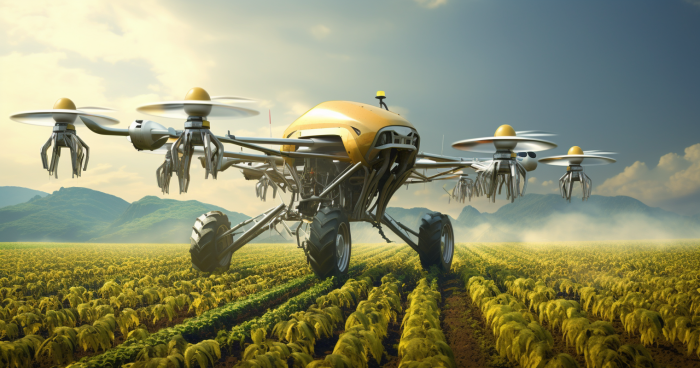Agriculture has been the backbone of human civilization for thousands of years. Over time, the methods and tools used in farming have evolved significantly, with the advent of technology playing a crucial role in revolutionizing agricultural practices. Today, agriculture https://webdevelopmentpros.co.uk/ technology, often referred to as AgTech, encompasses a wide range of innovations aimed at increasing efficiency, sustainability, and productivity in farming.
Current Trends in Agriculture Technology
Precision Agriculture
Precision agriculture involves the use of advanced technologies such as GPS, drones, and satellite imagery to optimize the management of crops and resources. By precisely mapping variations in fields, farmers can apply inputs such as water, fertilizers, and pesticides more efficiently, resulting in higher yields and reduced environmental impact.
Artificial Intelligence and Machine Learning
Artificial intelligence (AI) and machine learning algorithms are being increasingly employed in agriculture to analyze data and make data-driven decisions. These technologies can predict crop yields, detect diseases, and optimize planting schedules, leading to improved crop health and profitability.
Robotics and Automation
Robotic systems are revolutionizing farming by performing tasks such as planting, harvesting, and weeding with greater precision and efficiency than human labor. Automation in agriculture reduces the reliance on manual labor, addresses labor shortages, and improves overall productivity.
Benefits of Agriculture Technology
The adoption of agriculture technology offers numerous benefits to farmers and the environment:
Increased Efficiency and Productivity
Technology streamlines farming operations, enabling farmers to accomplish tasks more quickly and accurately. Automation of repetitive tasks frees up time for farmers to focus on strategic decision-making, leading to higher productivity and profitability.
Resource Conservation
Agriculture technology promotes sustainable use of resources such as water, land, and energy. Precision irrigation systems deliver water directly to plants’ roots, minimizing water wastage. Furthermore, smart farming practices reduce soil erosion and chemical runoff, preserving soil fertility for future generations.
Improved Crop Quality
By leveraging technology, farmers can monitor crop health in real-time and intervene promptly to mitigate potential risks such as pests, diseases, and adverse weather conditions. This results in higher-quality produce that meets consumer demands for safety and freshness.
Challenges and Concerns
Despite its numerous benefits, agriculture technology also faces several challenges:
Cost of Implementation
The initial investment required to adopt advanced agricultural technologies can be prohibitive for small-scale farmers, particularly in developing countries. Access to affordable financing and subsidies is essential to ensure widespread adoption of technology across all farming sectors.
Accessibility to Technology
Rural areas often lack the necessary infrastructure and connectivity to fully leverage agriculture technology. Bridging the digital divide through initiatives such as expanding internet access and providing training and support to farmers is critical for equitable technology adoption.
Environmental Impact
While technology can enhance agricultural sustainability, it also poses risks to the environment if not implemented responsibly. Concerns include the overuse of agrochemicals, loss of biodiversity, and increased energy consumption. Sustainable practices and regulatory oversight are necessary to mitigate these risks.
Examples of Innovative Agriculture Technologies
Several innovative technologies are transforming the agricultural landscape:
Drones for Crop Monitoring
Unmanned aerial vehicles (UAVs) equipped with cameras and sensors enable farmers to monitor crop health, assess field conditions, and detect pests and diseases from above. Drones provide valuable data for decision-making and can cover large areas quickly and efficiently.
Sensor-Based Irrigation Systems
Smart irrigation systems utilize sensors to measure soil moisture levels and weather conditions, enabling precise water delivery based on plants’ needs. By optimizing water usage, these systems conserve water resources and improve crop yields while reducing water-related expenses.
Vertical Farming
Vertical farming involves growing crops in vertically stacked layers, often indoors under controlled environmental conditions. By maximizing space utilization and minimizing water and pesticide usage, vertical farms produce high yields of fresh produce year-round, making them ideal for urban areas with limited arable land.
Impact of Agriculture Technology on Farmers
Empowerment of Small-Scale Farmers
Technology democratizes access to information and resources, empowering small-scale farmers to compete in the global market. Mobile apps provide farmers with real-time market prices, weather forecasts, and agronomic advice, enabling them to make informed decisions and improve their livelihoods.
Changing Role of Farmers
As agriculture becomes increasingly digitized and automated, the role of farmers is evolving from manual laborers to data-driven decision-makers and technology integrators. Farmers must acquire new skills in data analysis, robotics, and digital literacy to remain competitive in the modern agricultural landscape.
Education and Training Needs
To fully harness the potential of agriculture technology, comprehensive education and training programs are essential. Governments, academic institutions, and industry stakeholders must collaborate to provide farmers with the knowledge and skills needed to adopt and effectively utilize new technologies.
Government Initiatives and Policies
Governments play a crucial role in promoting the adoption of agriculture technology through supportive policies and initiatives:
Subsidies for Technology Adoption
Many governments offer financial incentives such as subsidies and tax credits to encourage farmers to invest in advanced agricultural technologies. These subsidies help offset the initial costs and promote widespread adoption across all farming sectors.
Regulation of Genetically Modified Organisms (GMOs)
Regulatory frameworks governing the use of genetically modified organisms (GMOs) vary widely between countries. While GMOs have the potential to increase crop yields and resilience, concerns about their environmental and health impacts necessitate stringent regulation and oversight.
Support for Sustainable Practices
Governments are increasingly prioritizing sustainable agriculture practices to address environmental concerns and ensure long-term food security. Initiatives such as organic farming incentives, agroecology research funding, and soil conservation programs promote environmentally friendly farming methods.
Future of Agriculture Technology
The future of agriculture technology holds tremendous promise for addressing global challenges such as climate change, population growth, and food security:
Integration of IoT and Big Data Analytics
The Internet of Things (IoT) and big data analytics will enable real-time monitoring and optimization of farm operations.

